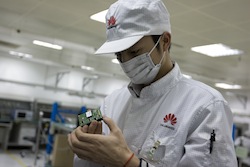In a salvo of new 4G offerings, Chinese manufacturing giant Huawei unveiled its new LTE-B ‘FusionNet’ architecture, designed to improve Cell Edge User (CEU) throughput by at least 500 percent, via a series of multi-RAT, multi-band and multi-layer HetNet enhancements for ‘No-Edge’ networks of seamless high-speed coverage, the company said.
According to Huawei, FusionNet has several core technologies for LTE-B, which include multi-stream aggregation, interference coordination, traffic adaption and spectrum efficiency optimisation.
It also coordinates existing LTE and LTE-A deployment and technology, including CoMP and carrier aggregation, delivering a ‘fusion’ of multi-RAT, multi-band and multi-layer networks.
Huawei said that a core benefit of FusionNet lies in its ability to substantially lower network capital and operational expenditure. FusionNet also offers ultra-wideband, zero waiting and ubiquitous connectivity capabilities.
Meanwhile, the Chinese vendor has also just launched an Ultra Node prototype design for future mobile broadband base stations, which the company said would enhance the spectrum utilisation and overall network efficiency to achieve a 50 Gbps peak data speed in a single node.
Its core technologies (in addition to a redesigned antenna structure) greatly improves antenna performance, satisfies wideband and high network performance capacity demands, reduces networks costs and power loss, realises multi-stream aggregation of ultra-widebands, and allows for greater channel capacity given implementation of a more advanced multi-antenna encoding algorithm.
Also now available is Huawei’s next-generation SingleEPC that uses ultra-broadband, 6-mode atom-level convergence and a Multi-Service Engine for mobile broadband services. According to Huawei, SingleEPC offers is the only product to feature the 6-mode atom-level convergence for a convergent packet-switched core for multiple radio access modes.
SingleEPC also supports GPRS, UMTS, LTE-FDD, LTE-TDD, CDMA and WiFi. SingleEPC further enables 64 times more signalling overload control than previous generations, while the company asserted that the most important innovation of SingleEPC is the Multi-Service Engine, which it claims as a ‘world first’ for web and video acceleration optimisation. The MSE is integrated into the packet switch core, and provides an LTE voice capability that will be commercially available later in 2013.
The company also launched its LampSite product for indoor coverage, using TD-LTE technology supporting O&M visibility with multi-band and multimode capabilities.


